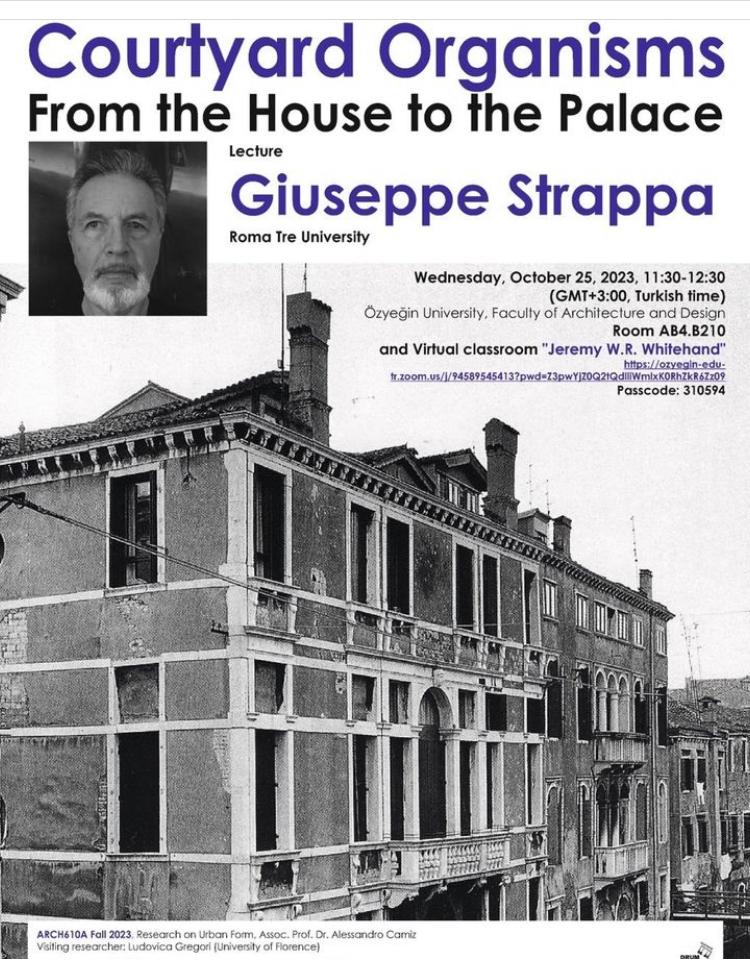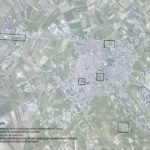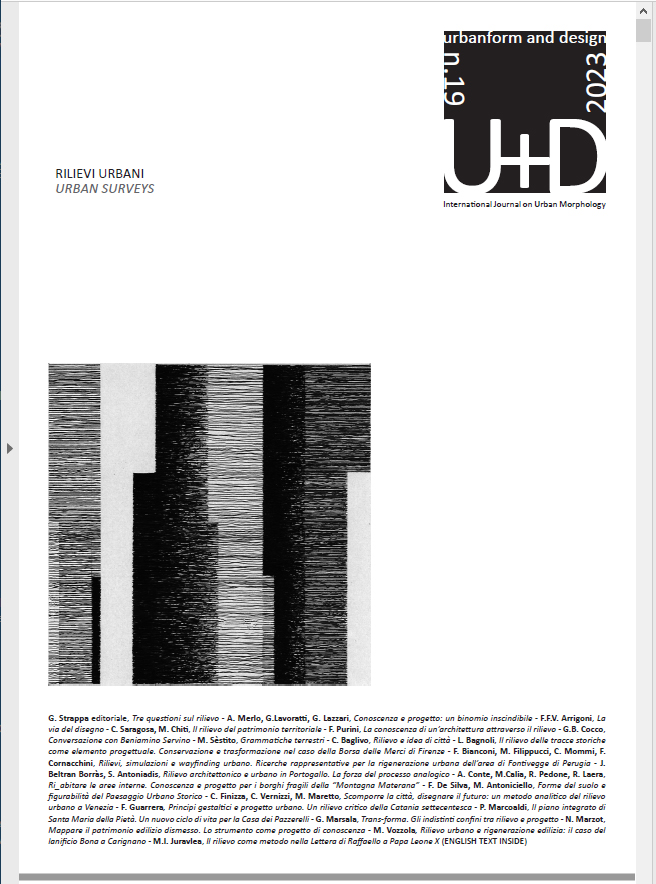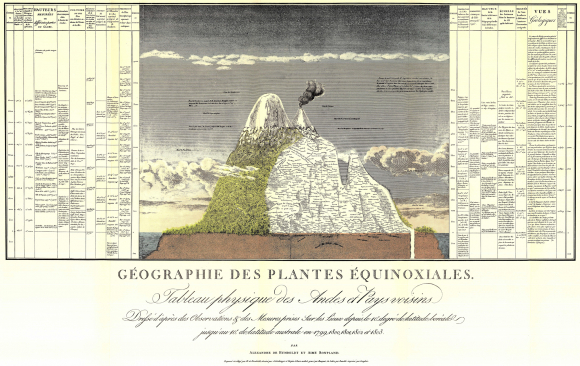ISTANBUL – OZYEGIN UNIVERSITY

ISTANBUL – OZYEGIN UNIVERSITY

Scuola/Workshop di Progettazione in Area Archeologica
Canosa di Puglia | 18-28 settembre 2023

last Canosa Workshop Antico Futuro – programma DEF

2023_anno X_n.19
Editoriale_Editorial
Giuseppe Strappa
Tre questioni sul rilievo
Three questions on survey
Riflessioni_Reflections
Alessandro Merlo, Gaia Lavoratti, Giulia Lazzari
Conoscenza e progetto: un binomio inscindibile
Knowledge and design: an inseparable pair
Saggi e Progetti_Essays and Projects
1| Fabrizio Franco Vittorio Arrigoni
La via del disegno
The Path of Drawing
2| Claudio Saragosa, Michela Chiti
Il rilievo del patrimonio territoriale
The survey of territorial heritage
3| Franco Purini
La conoscenza di un’architettura attraverso il rilievo
The knowledge of an architecture through the survey
4| Giovanni Battista Cocco
Conversazione con Beniamino Servino
Conversation with Beniamino Servino
5| Marcello Sèstito
Grammatiche terrestri
Territorial grammars
Punti di vista_Viewpoints
Recensioni e Notizie_Book Reviews & News
U+D Urban form and design | n.20 2023 call
Territorio e Disegno urbano
Strumenti, studi, progetti
Scadenza: 1 settembre 2023
Pubblicazione: entro dicembre 2023
Territory and Urban Design
Tools, studies , design
Deadline: September 1 st 2023
Publication: December 2023
Sotto la spinta di un’ urbanizzazione crescente, sono stati cancellati i confini tra la città e l’area vasta che ad essa fa riferimento, stabilendo inediti legami tra paesaggi naturali, urbani e metropolitani . Nella condizione contemporanea, questi legami sono leggibili come complessa rete di relazioni fisiche, (naturali e antropiche), e immateriali che hanno perso i tradizionali caratteri di organicità del territorio storico
La città contemporanea va ormai pensata all’interno di un nuovo paradigma dinamico: come momento di provvisorio equilibrio nel divenire d i parti e sezioni di scambio che ne ridefiniscono costantemente l’ assetto morfologico.
Il territorio, a sua volta, è oggi costellato d i piccoli centri che stanno affrontando a volte fasi di abbandono, ma anche di una inedita trasformazione e nuovi sviluppi nel rapporto tra il paesaggio agrario e ciò che resta del paesaggio naturale, facendo pensare a una possibile, originale organicità futura……
CONTINUA A LEGGERE

U+D Editoriale n.19 – Strappa (1)
editoriale n.19
Il modo nel quale questo numero della rivista si occupa del problema del rilievo (degli edifici, della cittá, del territorio), non riguarda solo la documentazione e la descrizione delle forme che la realtà costruita presenta ai nostri occhi.
Crediamo che esso si ponga, per l’architetto, soprattutto come questione di conoscenza e di rappresentazione di quella conoscenza. Due termini di difficile conciliazione.
1. Il rilievo e la raffigurazione oggettiva della realtà. Il problema di ogni rilievo è il rapporto di impossibile coincidenza tra le forme del costruito reale (le stratificazioni
degli organismi urbani, l’annodarsi e dipanarsi di percorsi di crinale
e fondovalle) e la loro descrizione grafica, ovvero la presunzione di esattezza di piante, mappe, carte geografiche, incerte e parziali anche quando sono
tracciate con i più sofisticati strumenti digitali. Non è una questione nuova. È, in fondo, l’eterno problema della geografia culturale posto da Alexander von Humboldt, per il quale non basta rappresentare su un piano nazioni e continenti.
Occorre descrivere, piuttosto, la vita che si svolge sulla crosta terrestre, l’intrico della vegetazione delle foreste e l’ordine delle coltivazioni, le famiglie di animali selvatici e quelle delle specie domestiche, il succedersi delle generazioni degli uomini e i meandri misteriosi di fiumi solo in parte esplorati. “Il risultamento più importante d’uno studio razionale della natura – scriveva
– quello si è di afferrare l’unità e l’armonia in così immensa farragine di cose e di potenze, d’abbracciare con pari ardore ciò ch’è dovuto alle scoperte dei secoli trascorsi ed a quelle del tempo in cui viviamo”. Humboldt introduce,
nella geografia immobile di metà ’800, il tempo che scorre. Eppure, nonostante i suoi viaggi in ogni contrada del mondo, il risultato, i cinque monumentali volumi del suo Cosmos, è destinato al fallimento. Le sue meravigliose mappe, che intendono catalogare e portare a unità il caos della vita che pullula sul pianeta trasformandola in una ordinata tassonomia, sono, insieme, un laboratorio di forme e una composizione intellettuale, piuttosto che che una sistematica descrizione dell’oggetto di studio. Perché è proprio questo il centro del problema. È nel tentativo di classificare, catalogare, ordinare le forme del suolo naturale o trasformato dalla mano dell’uomo che la realtà rivela la sua irriducibile complessitá, il suo sostrato enigmatico. È il problema irrisolvibile del rilievo e, insieme, quello della morfologia urbana.
……………………….
Continua a leggere Editoriale n.19 – Strappa (1)